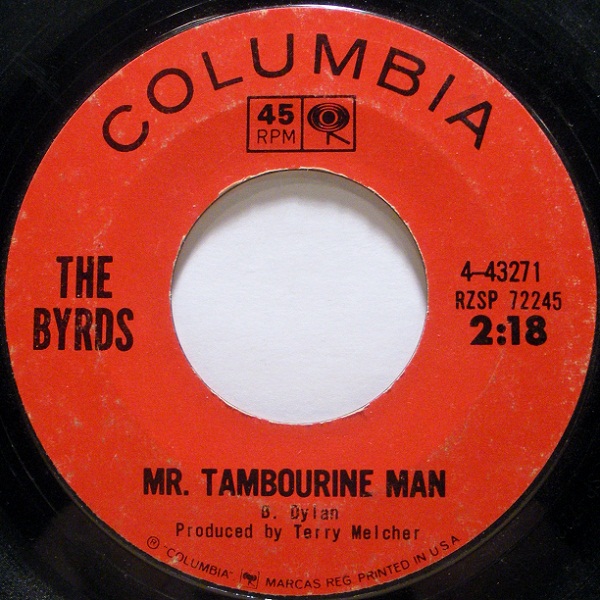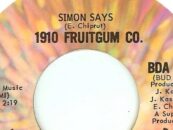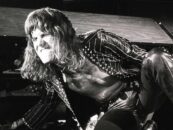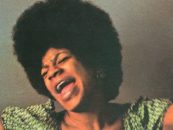When the Byrds Soared to #1 With ‘Mr. Tambourine Man’
by Best Classic Bands Staff If the rise of folk-rock as a commercial force can be carbon-dated to a single event, this would be it, on June 26, 1965. It was on this date that an acoustic ballad written by America’s leading young folk singer, and transformed into something new and exciting–a rock ‘n’ roll song–reached the top of the charts.
If the rise of folk-rock as a commercial force can be carbon-dated to a single event, this would be it, on June 26, 1965. It was on this date that an acoustic ballad written by America’s leading young folk singer, and transformed into something new and exciting–a rock ‘n’ roll song–reached the top of the charts.
The stories of the origin of the Bob Dylan song–the first single released by The Byrds on Columbia Records–vary. Some say “Mr. Tambourine Man” is Greenwich Village folk scene guitarist Bruce Langhorne, who would also play a Turkish hand drum with small bells attached that sounded like a tambourine. Others claim it was the nickname for Dylan’s pot dealer. The song is thought to recount a night Dylan spent at Mardi Gras in New Orleans in 1964.
The recording that topped both the U.S. and U.K. charts was not played by the Los Angeles-based band formed in the wake of the Beatles by folkies Jim McGuinn (later to change his first name to Roger), Gene Clark, David Crosby, Chris Hillman and drummer Michael Clarke. Instead, the L.A. studio musicians known as the Wrecking Crew backed McGuinn on his Rickenbacker electric 12-string guitar – one of the signature sounds of the track and band alongside the group’s luscious vocal harmonies.
The Byrds’ version was released on April 12 and took off almost instantaneously. Although other groups had sought to apply the lyrical sophistication of folk music to rock instrumentation, the Byrds were the first to put everything in the right places: McGuinn’s dreamy lead vocal and the mysterious story he told proved a perfect fit for the times. Soon, other acts, among them Simon and Garfunkel, the Lovin’ Spoonful, the Turtles, the Mamas and the Papas, Sonny and Cher and others would also enjoy hit records in the folk-rock style begun by The Byrds onto the charts.
Related: Our Album Rewind of the Mr. Tambourine Man LP
Although the full Byrds band did not play on their initial smash hit, soon enough they took full control of their own music, remaining one of the most successful and influential American rock bands of the remainder of the ’60s, and on into the early ’70s. Even long after the Byrds split up (following numerous personnel changes that left only McGuinn from the original band), their influence could be detected in the music of groups like R.E.M., Tom Petty and the Heartbreakers and the Bangles.
If you’re wondering how Dylan’s own version scored on the Singles chart, you’re not alone. But you’ll be searching in vain; it was never released as a single. The Byrds would soon enjoy a second #1 with “Turn! Turn! Turn!” [The album is available in the U.S. here and in the U.K. here.]
Related: Dylan in ’65: Evolving to electric
- Emerson, Lake & Palmer ‘Welcome Back My Friends’ is Latest in Fan Memories Book Series - 12/25/2025
- That Haunting Female Vocal On ‘Gimme Shelter’ - 12/25/2025
- Musician Deaths of 2025 - 12/24/2025






6 Comments so far
Jump into a conversationSeeing McGuinn and Hillman perform with Marty Stewart and The Fabulous Superlatives on the “Sweetheart of The Rodeo” anniversary tour was one of the greatest thrills of my life — I actually had tears in my eyes at points throughout the show. The “Sweetheart” material was enjoyable, but what really got me was all the other Byrds songs that they performed so well, including much from the “Notorious Byrd Brothers” LP, which was like seeing a dream come true. While Superlatives’ bassist Chris Scruggs played bass on most of the Byrds’ songs, Hillman did take over to play his classic bass part on “Mr. Tambourine Man,” and it was thrilling.
Of all the classic bands out there that could offer something worthwhile with a true reunion, I think the Byrds might top the list — they have so much great material that spans so many years and genres. I know Crosby has expressed enthusiasm for the idea (and even promised to “keep his mouth shut lol), but apparently McGuinn and Hillman know better. And like Stills, Nash & Young, want no part of him. Having been in bands all my life, I truly do understand the dynamic that happens in them with problematic members, and that doesn’t usually go away over time, even though you’d think it might. It’s a shame though, because it’s obvious that Crosby is an amazingly creative force — never more so than in his current later years. But while he was not a primary songwriter for the Byrds or CSN, he contributed so of the most interesting and broad-based material to each of his former bands. He may be a chronic problem child, but in terms of the body of music that was created in each band, Crosby was an essential element. It’s just a shame that he’s always thought so much of himself.
Marty Stuart.
You and I must be twins. I love the Byrds felt they were unfairly compared to The Beatles but they were our best. I was lucky enough to see McGuinn perform solo played all the hits just him and his guitars. My brother you would have cried—about 10 years or so ago.
The reason why The Wrecking Crew was utilized on the single “Mr. Tambourine Man” and its flipside “I Knew I’d Want You” was because the band hadn’t musically gelled yet, hence that only Roger McGuinn played his trusty Rickenbacker 12-string electric guitar. There is also a tambourine on the track, possibly an overdub by Hal Blaine, as he did play the drums.
When the sessions for the album began, the band had developed and was now capable of playing their own instruments on the album and subsequent recordings.
Yes, David Crosby has an ego, but he also had the decency to acknowledge that he was not easy to work with and he deserved to be fired from The Byrds (I’m just paraphrasing).
When I first heard the Byrds’ “Mr. Tambourine Man” on the radio—almost certainly on WARM (“The Mighty 590”)—back in early 1965, I probably ran to the record store after school and bought it (if I had any money saved from pulling weeds and mowing lawns).
“Mr. Tambourine Man” had a kind of intellectual effect on me similar to the more visceral impact that the Kinks’ “You Really Got Me” had had a few months earlier. Both were impetuses in my becoming one of the few “serious” rock music aficionados in my hometown (at least, one of the few I knew about).
Based on a single single—and I was almost as blown away by the flip-side, “I Knew I’d Want You,” as the hit side—the Byrds immediately became my Faveravest Group in the Whole Wide World!
To this day, “Mr. Tambourine Man” remains one of my “time travel records,” whereby when I hear it, I am transported back in time to when it was a hit and I was 13-going-on-30. (Yeah yeah yeah—few of us in out “right” adult mind would want to relive the confusion and anguish of their teendom but, for a few minutes, I can handle it.)
Thanks for the article!
Re: Your first sentence, that is exactly what I did. I heard it on the radio, scraped up some change and headed on my bike to the department store a few miles away that I knew always got the new records first. They are still one of my all-time favorite bands. A few weeks later I returned to the same store and bought a pair of granny glasses like the ones McGuinn wore.